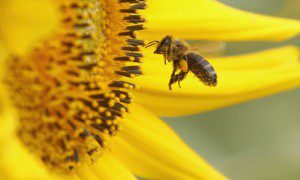Contributing writer for Wake Up World
Good news on the honeybee front — a team of scientists in the UK have created a biopesticide made from spider venom and plant protein that may provide hope for the endangered pollinators.
A study published in the research journal Proceedings of the Royal Society B [PDF] states that the experimental, nontoxic biopesticide Hv1a/GNA is “unlikely to cause detrimental effects on honeybees.”
The insects were exposed to assorted levels of Hv1a/GNA for over a week and were only mildly affected. The substance did not have any measurable influence on the bees’ calcium channels, which are associated with learning and memory — an important factor because bees need to memorize routes to food and communicate it to the colony. And since developing honeybees were able to break down the substance during digestion, it did not have an impact on larvae.
[pro_ad_display_adzone id=”110028″]
A silver bullet solution for bee colony collapse?
For almost two decades, the world has been experiencing a mass die-off of honeybees — a full third of commercial beehives, which equates to over a million colonies each year. Classified as one of the biggest threats to our food supply by the USDA bee and pollination program, the cause of this mysterious syndrome was unknown up until recently. Four studies have shown that a major player in colony collapse turns out to be a class of pesticides called neonicotinoids.
Reuters journalist Richard Schiffman reported,
“In the U.S. alone, these pesticides, produced primarily by the German chemical giant Bayer and known as ‘neonics’ for short, coat a massive 142 million acres of corn, wheat, soy and cotton seeds. They are also a common ingredient in home gardening products.”
Research published in the journal Science found that neonics contaminate pollen and nectar that bees come into contact with during their rounds. Since neonics are a nerve poison, the bees become disoriented and are unable to return to the hive. Moreover, a study in Environmental Science and Technology linked neonic dust released into the air during planting time with devastating colony losses. Purdue University etymologists, meanwhile, observed that bees at infected hives displayed symptoms of acute insecticide poisoning — including tremors, uncoordinated movement and convulsions. And the Harvard School of Public Health “actually re-created colony collapse disorder in several honeybee hives simply by administering small doses of a popular neonic, imidacloprid,” said Schiffman.
Even though Hv1a/GNA has potential as a safe pesticide alternative to neonicotinoid, colony collapse disorder is a complex dilemma, requiring a multi-pronged approach to correct. As Schiffman notes:
“Scientists believe that exposure to toxic pesticides is only one factor that has led to the decline of honey bees in recent years. The destruction and fragmentation of bee habitats, as a result of land development and the spread of monoculture agriculture, deprives pollinators of their diverse natural food supply. This has already led to the extinction of a number of wild bee species. The planting of genetically modified organism (GMO) crops — some of which now contain toxic insecticides within their genetic structure — may also be responsible for poisoning bees and weakening their immune systems.”
Article Sources
- http://rspb.royalsocietypublishing.org [PDF]
- http://blogs.reuters.com
- http://www.takepart.com
- http://www.plosone.org
- http://www.sciencemag.org
- http://www.ncbi.nlm.nih.gov
- http://www.hsph.harvard.edu [PDF]
- http://salsa3.salsalabs.com
Previous articles by Carolanne:
- Common Toxin in Your Pantry Causes Obesity, Diabetes, Infertility… and Much More
- Is Mold Making You Sick?
- Hemp – The Ultimate Cash Crop, Health Food and Environmental Savior Rolled Into One
- Slash your Organic Food Bill by Almost 90 Percent with This One Simple Method
- Confirmed by Science: You Really Can Change Your DNA – Here’s How
- Chemtrails: Learn How to Protect Yourself From These Treacherous Poisons
- Top 10 Food Frauds: Formaldehyde, Plastic, Melamine & Caustic Soda Found in Common Foods
- Autistic Boy With Higher IQ Than Einstein Discovers Gift After Removal From State-Run Therapy
- Enhance Spiritual, Mental and Physical Well-being with a Pineal Gland Detox
- Enterprising Community Aims for Total Food Self-Sufficiency with Free Edible Landscapes
- The Silent Toxin in Food that Provokes Cancer, Diabetes, Multiple Sclerosis and More
- DIY $2 Self-Watering Garden Bed – Grow Produce Easily, Even in the Toughest Drought Conditions
[pro_ad_display_adzone id=”110027″]







